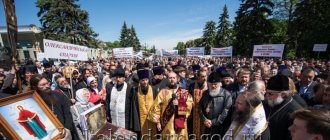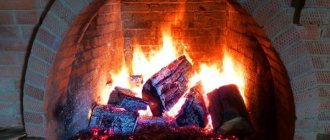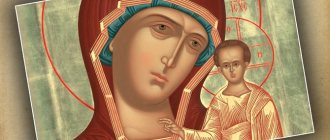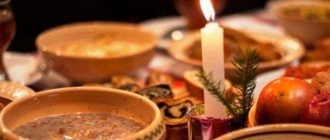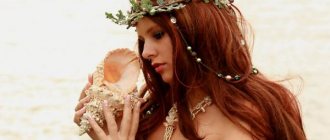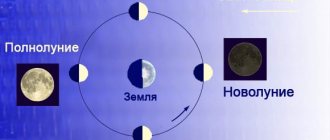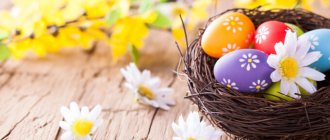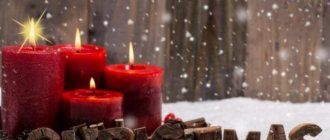History of origin
Every year on September 21, Orthodox Christians celebrate the Nativity of the Blessed Virgin Mary. This holiday is one of the main twelve. People call him the second Most Pure One. For several centuries in a row, Christians have been celebrating not only the Nativity of the Savior, but also the feast of the birth of his most holy mother. After all, it was the Immaculate Virgin Mary who gave believers the Son of God, who saved human nature from the Fall.
All the details of the birth of the Mother of God became known thanks to an apocryphal (not recognized by the Church) text called “The Proto-Gospel of James,” dating back to the middle of the 2nd century. The Holy Scripture itself does not mention this event (the birth of Mary).
The Immaculate Virgin was born in Jerusalem. Her parents lived in Nazareth. Father Joachim was a righteous and wealthy man. He had a lot of livestock. Joachim came from the family of the most glorious king David. The mother of the Virgin Mary was called Anna. She came from a family of clergy.
The couple led a righteous lifestyle, helped the poor, and brought gifts to God. Despite their prosperity, the holy couple had one huge problem - they did not have children. Parents constantly asked God to send them a child. After all, not having children among Jews was considered a punishment for sins. One day, Joachim’s clergyman did not accept gifts for the glory of the Almighty. After all, it was believed that a childless person does not have the blessing of God and has no right to count on the immortality of the soul.
Mary's father went into the desert out of grief and prayed to God for a long time, asking him to send him a child. Anna suffered the most. She also asked the Almighty to give her a child. And then an angel appeared to Anna and said that her prayer had been heard by God, and soon she would give birth to a girl, about whom the whole world would talk. It was necessary to name the daughter Maria, which translated from Hebrew meant “lady” and “hope.” An angel appeared to Joachim and told him to return to his wife and wait for the birth of his daughter.
Soon the already middle-aged couple had a long-awaited daughter, Maria. This happened on September 21. The Church even celebrates the day of Anna’s conception of her most holy daughter. True, there are versions that it was not immaculate. Of course, the Immaculate Virgin Mary was sinless, but was born naturally. The Orthodox Church only considers the Nativity of the Savior pure and immaculate.
Orthodox church holidays in May 2020
May 1, 2020 Tuesday
- St. John, disciple of St. Gregory Dekapolite.
- Martyrs Victor, Zotik, Zenon, Akindinus and Severian.
- Saint Cosmas the Confessor, Bishop of Chalcedon, and his associate Saint Auxentius.
- Maximovskaya Icon of the Mother of God.
May 2, 2020 Wednesday
- Fast day.
- Mozdok and Dubenskaya-Krasnogorodskaya icons of the Mother of God.
- Venerable John of the Old Cave.
- Martyrs Feona, Christopher and Antonin warriors.
- Blessed Matrona of Moscow.
Thursday May 3, 2020
- Venerable Theodore Trikhina (hair shirt).
- Venerable Alexander Oshevensky.
- Infant Martyr Gabriel of Slutsk (Bialystok).
- Cyprus and Kipyazhskaya icons of the Mother of God.
Friday May 4, 2020
- Fast day.
- Hieromartyr Iannuarius the bishop and with him the martyrs Proculus, Sossius and Faustus the deacons, Disiderius the reader, Eutyches and Acution the laity.
- Hieromartyr Theodore, also in Perga, his mother Philippia, Dioscorus the priest and two warriors: Socrates and Dionysius.
- Martyrs Isaac, Apollos and Codratus.
May 5, 2020 Saturday
- Venerable Theodore Sikeot, Bishop of Anastasiople.
- Apostles Nathanael, Luke and Clement.
- Transfer of the relics of the blessed Prince Vsevolod-Gabriel of Pskov.
- Venerable Vitaly monk.
Sunday May 6, 2020
- Great Martyr George the Victorious.
- Iveron Icon of the Mother of God.
- Martyrs of Queen Alexandra.
- Martyrs Anatoly and Protoleon.
Monday May 7, 2020
- Martyr Sava Stratelates (voivode) and with him 70 soldiers.
- St. Savva of Pechersk, in the Near Caves.
- St. Alexis, the recluse of Pechersk, in the Near Caves.
- Molchensk Icon of the Mother of God.
Tuesday May 8, 2020
- Apostle and Evangelist Mark.
- Saint Macedonius, Patriarch of Constantinople.
- Venerable Sylvester of Obnor.
- Constantinople Icon of the Mother of God.
May 9, 2020 Wednesday
- Day of Remembrance of the Dead (Warriors).
- Celebrating the Feast of Mid-Pentecost.
- Hieromartyr Basil, Bishop of Amasia.
- Saint Stephen, Bishop of Great Perm.
- Fast day.
Thursday May 10, 2020
- Apostle and Hieromartyr Simeon, Bishop of Jerusalem, relative of the Lord.
- Venerable Stephen, Abbot of Pechersk, Bishop of Vladimir-Volyn.
- Righteous Eulogius the Stranger.
- Icons of the Mother of God “Kazan” in the village of Aleksandrovka.
Friday 11 May 2020
- Apostles from 70: Jason and Sosipater, the virgins of Kerkyra and others who suffered with them.
- Martyrs Dada, Maximus and Quintilian.
- fast day
May 12, 2020 Saturday
- The Nine Martyrs of Cyzicus: Theognis, Rufus, Antipater, Theostichus, Artema, Magnus, Theodotus, Thaumasius and Philemon.
- Venerable Memnon the Wonderworker.
- Martyrs Diodorus and Rhodopian the Deacon.
- Venerable Nectarius of Optina.
Sunday May 13, 2020
- Apostle James Zebedee, brother of John the Theologian.
- Finding the relics of St. Nikita, Bishop of Novgorod.
- Saint Ignatius Brianchaninov, Bishop of the Caucasus and Black Sea.
- Saint Donatus, Bishop of Euria.
Monday 14 May 2020
- Prophet Jeremiah.
- Venerable Paphnutius of Borovsky.
- Venerable Martyrs of Athonite Euthymius, Ignatius and Akakios.
- Hieromartyr Macarius, Metropolitan of Kyiv.
Tuesday May 15, 2020
- Saint Athanasius the Great, Archbishop of Alexandria.
- Transfer of the relics of the noble princes, passion-bearers Boris and Gleb, in Holy Baptism of Roman and David.
- Putivl and Vutivanskaya icons of the Mother of God.
Wednesday 16 May 2020
- Martyrs Timothy the Reader and the Moors.
- Venerable Theodosius, abbot of Kiev-Pechersk.
- Icons of the Mother of God: the Dormition of the Kiev-Pecherskaya, brought from Constantinople, Pecherskaya, Svenskaya, Yaskinskaya and Blachernae.
- Fast day.
Thursday 17 May 2020
- Ascension of the Lord.
- Martyr Pelagia, Virgin of Tarsus.
- Saints Nikita, Cyril, Nikifor, Clement and Isaac, brothers Alfanov (Sokolnitsky) in Novgorod.
- Old Russian Icon of the Mother of God.
May 18, 2020 Friday
- Fast day.
- After-feast of the Ascension of the Lord.
- Great Martyr Irene.
- Icon of the Mother of God “Inexhaustible Chalice”.
May 19, 2020 Saturday
- After-feast of the Ascension of the Lord.
- Righteous Job the Long-Suffering.
- Venerable Job, abbot and wonderworker of Pochaev.
- Martyrs Barbarian the warrior, Bacchus, Callimachus and Dionysius.
Sunday May 20, 2020
- After-feast of the Ascension of the Lord.
- Chelny Icon of the Mother of God, called “Tenderness”.
- Remembrance of the appearance in heaven of the Cross of the Lord in Jerusalem.
Monday 21 May 2020
- After-feast of the Ascension of the Lord.
- Apostle and Evangelist John the Theologian.
- Venerable Arseny the Great.
- Saints Arseny the hardworking and Pimen the faster, Pechersk, in the Far Caves.
Tuesday May 22, 2020
- After-feast of the Ascension of the Lord.
- Transfer of the relics of Saint and Wonderworker Nicholas from Myra in Lycia to Bar.
- Prophet Isaiah.
- Perekop Icon of the Mother of God.
May 23, 2020 Wednesday
- Fast day.
- After-feast of the Ascension of the Lord.
- Apostle Simon the Zealot.
- Kiev-Brotherly Icon of the Mother of God.
Thursday May 24, 2020
- After-feast of the Ascension of the Lord.
- Equal-to-the-Apostles Methodius and Cyril, Slovenian teachers.
- Hieromartyr Mokiya.
- Equal to the Apostles Rostislav, Prince of Great Moravia.
Friday May 25, 2020
- Fast day.
- Celebration of the Feast of the Ascension of the Lord.
- Saint Epiphanius, Bishop of Cyprus.
- Saint Herman, Patriarch of Constantinople.
- Glorification of the Hieromartyr Hermogenes, Patriarch of Moscow and All Rus', miracle worker.
May 26, 2020 Saturday
- Trinity Parents' Saturday
- The virgin martyr Glyceria and with her the martyr Laodicea, the prison guard.
- Righteous Glykeria Virgin, Novgorod.
- Transfer of the relics of the Venerable Martyr Macarius, Archimandrite Kanevsky, Abbot of Pinsk, Pereyaslavl Wonderworker.
Sunday May 27, 2020
- Day of the Holy Trinity
- Martyr Isidore.
- Blessed Isidore, Christ for the sake of the holy fool, Rostov wonderworker.
- Icons of the Mother of God: Yaroslavl, Terebinsk and Seraphim-Ponetaevskaya.
Monday 28 May 2020
- Holy Spirit Day
- Tupichevskaya and Cyprus icons of the Mother of God.
- Venerable Pachomius the Great.
- Saint Isaiah, Bishop of Rostov, wonderworker.
- The day of the murder of the Blessed Tsarevich Demetrius of Uglich and Moscow.
Tuesday May 29, 2020
- Trinity Week.
- After-feast of Pentecost.
- Venerable Theodore the Sanctified.
- Transfer of the relics of St. Ephraim of Perekom, Novgorod wonderworker.
May 30, 2020 Wednesday
- Trinity Week.
- After-feast of Pentecost.
- Apostles from 70: Andronicus and Saint June, his assistant.
- Venerable Euphrosyne, in the world Evdokia, Grand Duchess of Moscow.
May 31, 2020 Thursday
- Trinity Week.
- After-feast of Pentecost.
- Memorial Day of the Holy Fathers of the Seven Ecumenical Councils: the martyr Theodotus of Ancyra and the seven martyrs: Alexandra, Tecusa, Claudia, Faina, Euphrasia, Matrona and Julia.
- Martyrs Peter, Dionysius, Andrew, Paul, Christina, Heraclius, Paulinus and Venedim.
- Koretsk Icon of the Mother of God “Helper of Sinners”.
Celebration traditions
The Holy Church began to celebrate the Nativity of the Immaculate Virgin Mary only in the 5th century. Christians have been glorifying the Mother of God for many centuries in a row, who gave birth to the world a Savior, who took upon himself all the sins of mankind and atoned for them at the cost of his own life.
This is the first holiday celebrated after the beginning of the church year (September 14). In honor of the Nativity of the Mother of God, the clergy annually perform a festive Liturgy. The birth of the Immaculate Virgin Mary is celebrated on September 21. The date of the holiday does not shift and does not depend on other church celebrations. In 2020, as well as in 2020 and in future years, the Nativity of Mary will be celebrated on September 21.
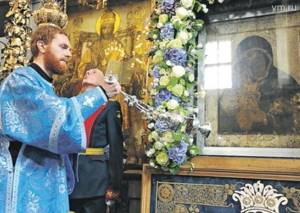
Divine service
In honor of the Nativity of the Virgin Mary, a festive service is held in churches on September 21. During the Liturgy, the troparion, kontakion, dignification and magnification are read. For the holiday, all clergy prepare festive sermons in which they talk about the miracle of the birth of the Virgin Mary. The Almighty gave the daughter Mary to elderly and barren parents. This woman later became the mother of the Son of God, who saved humanity from the Fall.
Canon
In the morning at the festive service, an entire solemn poem consisting of nine songs is read. Each hymn consists of an irmos (initial stanza) and several troparion stanzas glorifying the Mother of God. The entire text of the festive canon is dedicated to the Nativity of Mary and the glorification of the Mother of God. The songs ask to confirm believers in the faith and send them forgiveness of sins.
Song 1
Irmos: Come, O people, let us sing a song to Christ God, who parted the sea and taught the people, even as He brought forth from the work of the Egyptians, as if He were glorified.
Come, faithful ones, rejoicing in the Divine Spirit, Even from this barren day we will honor the Ever-Virgin Lady who came to save people with songs.
Rejoice, Pure One, Mother and Servant of Christ God, Even the first Intercessor of bliss, the human race, we all worthily glorify Thee with songs.
Today a bridge is born of life, whereby men glorify Christ the Giver of Life with songs, the cry of the fall, which was found from hell.
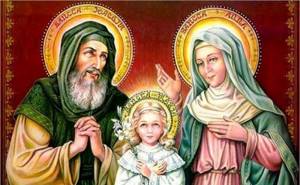
Song 3
Irmos: Establish us in You, Lord, the Tree that kills sin, and plant Your fear in the hearts of us who sing of You.
You lived immaculately to God, begetting Salvation of all, God-wisdom parent of the Creator of the Birth and our God.
The Lord, who exuded life to all, from barrenness, gave birth to the Virgin, who willed to dwell in Nyuzha, and after Christmas, preserving the incorruptibility.
Anna's fruit, Mary, today, who gave birth to the life-giving grape, as we sing to the Mother of God, the Representative of all and the Helper.
Sedalen, voice 4
The Virgin Mary and Mother of God truly, like a cloud of light, will rise to us today and will come from the righteous to our glory. Adam is not condemned to anyone, and Eve is freed from her bonds, and for this reason we cry out loudly with boldness to the One Pure Ones: joy proclaims Your Nativity to the whole universe.
Song 4
Irmos: Hear the Lord, hear Your gaze and glorify You, the One Lover of Mankind.
We sing praises to You, Lord, who has given the faithful a saving refuge to all, Who gave birth to You.
You are the bride of God, show Christ praise and power to all who sing Your sacrament faithfully.
Unartful Lady, with Your prayers we deliver from sins, we prudently please You all.
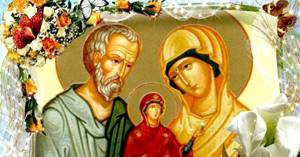
Song 5
Irmos: The hay-written darkness of fortune-telling has destroyed and the faithful with the arrival of the truth, the Virgin Mary, illuminating the hearts, and instruct us with Your light, Christ.
Let us sing to the people of all the guilt of being guilty of us: Even though the prophets rejoice in this image, the revealed salvation from Him is fruitful.
From the dry vegetation of the priest's rod, Israel was shown insight, and now the lightness of the vegetated shines gloriously, from the barrenness an all-glorious birth.
Song 6
Irmos: Jonah cried out to the Lord from the whale: You raise me up from the depths of hell, I pray, so that as a Deliverer, with a voice of praise, I will devour the truth in the Spirit.
To the Lord, in the sorrow of barrenness, the parents cried out to the Mother of God of Godly wisdom, and to this mother from generation to generation, for common salvation and praise.
I have received the Heavenly gift from God, worthy of the Mother of God, the parents of the Divine Wisdom, the samekh of the Cherubim who carried more than the Word, the Mother of God and the Creator.
Kontakion, voice 4
Joachim and Anna were reproached by childlessness, and Adam and Eve were freed from the aphids of death, O Most Pure One, in Thy holy Nativity. Then Thy people also celebrate, having been freed from the guilt of sins, always calling upon Ty: the Mother of God and the Nourisher of our life bears barren fruits.
Ikos
The prayer and sighing of the barrenness and desperation of Joachim and Anna are favorable and in the ears of the Lord below, and the fruit of the vegetative life is life-giving to the world. She prays in the mountain, and she bears reproach in the garden, but with the joy of barrenness she gives birth to the Mother of God and the Nourisher of our life.
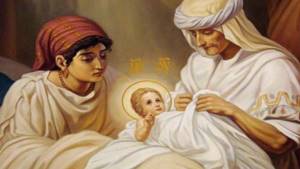
Song 7
Irmos: The bush in the mountain, the fire-scorching one, and the dew-bearing cave of the Chaldeans, has ordained You, the Bride of God, the Divine One, the Immaterial One in the material womb. You have received the fire without burning. Moreover, from You we sing: Blessed are You, God our Father.
Your lawmaker is forbidden to understand in material phenomena the great, Most Pure, mystery; not to be wise, earthly and zealous is figuratively punished sometimes. Moreover, I was amazed at the miracles, saying: Blessed be God our father.
The mountain and the door of heaven and the mental ladder of the divine face of the pronunciation of God, for from you the stone was cut off not by the hands of men, and the door, through which the Lord passed, who is the God of miracles ours.
Song 8
Irmos: In the cave of adolescence you sometimes represented Your Mother, O Lord, and this image is taken from the fire of the unburned One who came in, and we sing of You, who is the end of the day, and we extol to all eyelids.
Even to the God of our reconciliation the predestinated tabernacle even now begins to be, having given birth to the Word, to us the foolishness of the Flesh appears, Whom we eat, from those who do not exist in the hedgehog. moss, and we exalt to all ages.
Resolve the infertility of the worldly good, and clearly show the miracle of Christ, having come to the earthly, Him we eat, from those who do not exist, we receive Him, and exalt Him to all ages.
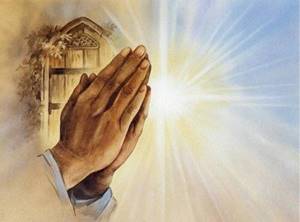
Song 9
Irmos: Even before the Sun, the Lamp of God, who arose, came to us carnally, from the side of the Maiden indescribably embodied, Blessed All-Pure, We magnify You, Mother of God.
Who has poured out water from stones to disobedient people, and with a submissive tongue bestows fruit from barren loins for our joy, You, Most Pure Mother of God, we deserve to magnify.
In vain is the ancient remover of condemnation and the foremother of correction, just as the generation was taken to God, to the Creator of the bridge, we magnify Thee, the Mother of God.
Luminous
From the barren day of Anna came forth, O Mother of God, all the incense of the Divine, fulfilling the ends of the world, and filling all creation with joy, Who sings, we worthily praise, as I exist on earth exceeded relatives.
Kontakion
The holiday kontakion says that Joachim and Anna atoned for their childlessness by giving the world the Mother of God. The mercy of the Almighty, who once saved Adam and Eve from corruption, descended on the couple. Mary gave birth to the Savior, who atoned for the sin of people at the cost of her own life. Barren Anna gave the world the Mother of God and, together with her husband Joachim, received the immortality of the soul.
“Joachim and Anna suffered the reproach of childlessness, and Adam and Eve were freed from mortal aphids, O Most Pure One, in Thy holy Nativity. Then Thy people also celebrate, having been freed from the guilt of sins, and always call upon Thy: infertility gives birth to the Mother of God and the nourisher of our life.
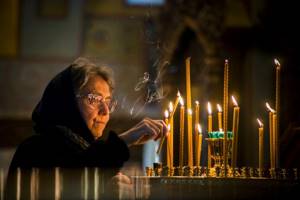
Joachim and Anna were freed from reproach for childlessness, and Adam and Eve were freed from death by Your holy Birth, Most Pure One. It is also celebrated by Your people, who have been delivered from the burden of sin, loudly exclaiming to You: the barren gives birth to the Mother of God and the nourisher of our Life.”
Signs for September 21, the day of the Nativity of the Virgin Mary

Signs by season and month
Among the numerous church holidays, the Nativity of the Blessed Virgin Mary occupies not the last place. All Orthodox Christians celebrate this first twelfth holiday of the new church year on September 21. On this day, God fulfills his promise to save humanity from damnation and destruction. Therefore, it is a holiday of universal joy.
There was a time when a married couple lived in Nazareth - Joachim and Anna. The couple lived according to conscience and justice, but they had no children. Childlessness was then considered a great sin, and when Joachim wanted to bring gifts to the Lord in the Jerusalem Temple, he was driven away. Having learned about this, Anna was very upset, but an Angel came to her with the news that she would soon conceive and give birth to a Daughter, whom all peoples on Earth would call the Virgin Mary.
The Church calls Anna and Jacob Fathers of God, since their Daughter gave birth to Jesus Christ.
September 21 is a holiday when all Orthodox Christians celebrate the Nativity of the Blessed Virgin Mary. And it is marked by the birth of the only woman worthy of giving birth to the Savior of the entire human world. Therefore, everyone loves and reveres this holiday very much and wants to know what signs are associated with the Nativity of the Blessed Virgin Mary.
According to ancient folk signs and superstitions, at Christmas it was customary to pray about everything that worried a person. It was believed that not a single prayer on this great day would remain unheard.
But you should remember that no matter when you turn to the Ever-Virgin in prayer, she will always help you. Such folk signs for the Nativity of the Blessed Virgin Mary indicate that the Mother of God rejoices when Orthodox Christians offer prayers to her.
This day was also called the Harvest Festival, and the better the harvest this year 2020, the longer the festival will last. It could take from three days to two weeks. On the days of the holiday, it was customary to visit relatives and friends, treat each other with dishes prepared from what the harvest gave. Depending on the hospitality of the table, they judged what harvest was expected next year.
If the fire is renewed at the Nativity of the Blessed Virgin Mary in 2020, then according to popular signs and superstitions, life will be prosperous.
According to an ancient legend, it is on the Nativity of the Blessed Virgin that human life begins a new circle. And the Nativity of the Blessed Virgin Mary is a kind of New Year 2020 for Christians. A candle was burning in every house in the village back then. It could not be extinguished, since there were no matches at that time, and other candles in the house were lit from this torch. But on Christmas Day it was customary to extinguish this torch and light it again. By doing this, people got rid of all diseases and troubles, leaving them far behind.
What winter does the Nativity of the Blessed Virgin Mary promise?
All folk signs and superstitions associated with the Nativity of the Blessed Virgin Mary are based on many years of experience and observations of people. Depending on what the weather was like on the day of the holiday, people judged the weather changes in winter:
- if on September 21, 2020 the day turned out to be clear, then you can enjoy such weather until the end of October;
- if on Christmas Day 2020 the morning sky turned out to be extremely clear and clear, expect cold weather to set in soon;
- If you notice fog on Christmas morning, expect rainy weather;
- if the holiday fog clears quickly, the weather will be unpredictable and changeable;
- if it rains on the morning of the holiday, the winter will be cold and the rains will last for forty days;
- If the sun on the day of the holiday quickly dries the dew on the grass, the winter will have little snow.
What should you not do on holidays?
Few people have ever thought about the fact that the Feast of the Nativity of the Blessed Virgin Mary falls during a time that is popularly called “Indian summer.” As the holiday approaches, all field work comes to an end.
This is the time when you can take a break from work, and the first holiday that comes after the completion of all work is the blessing and glorification of the Mother of God.
Therefore, on the Feast of the Nativity of the Blessed Virgin Mary in 2020, there are restrictions on what you should not do:
- Meat and alcohol should not be consumed during the holiday; fasting should be strictly observed;
- You cannot engage in any physical work; it is best to devote this day to prayers and spiritual reflection;
- You should also not swear during the holiday; spend it surrounded by friends and relatives.
© Author: Alexey Krivenky. Photo: depositphotos.com
Folk traditions and signs
There are many folk signs associated with the Feast of the Nativity of the Virgin Mary. On this day (September 21) it is customary to monitor the weather. If it is sunny on the Second Most Pure Day, then the second half of autumn will be warm. Fog and rain are harbingers of bad weather. Strong winds and a sharp drop in temperature foreshadow severe frosts in the winter months.
Dew is used to judge how much snow will fall in winter. If the grass on the Second Most Pure is wet before lunch, it means there will be a lot of snow in the winter months. If there is little dew on this day or it dries quickly in the sun, then the winter will be without snow.
Bird watching is recommended for September 21st. If they are circling high in the sky, it means that the second half of autumn will be warm. If the birds huddle close to the ground, the rest of the autumn days will be cold.
The Feast of the Nativity of the Virgin Mary has been celebrated for many centuries in a row. Over such a long time, a tradition has developed to celebrate this most glorious day. In the morning on the Second Most Pure Day, it is customary to go to church and glorify the Immaculate Virgin. In their prayers, childless women can ask Mary to give them a child. On this day, pregnant women pray to the Mother of God for an easy birth. Housewives traditionally bake bread on this day with the letters “R” (Christmas) and “B” (Virgin Mary). It is consecrated in the church and kept under icons. During illness, you need to break off a piece of bread and eat it.
On the morning of September 21, it is customary to wash your face with dew before sunrise. This procedure helps women maintain beauty and youth for a long time. Young girls, having washed themselves with dew or water from the river before sunrise, can soon wait for matchmakers.
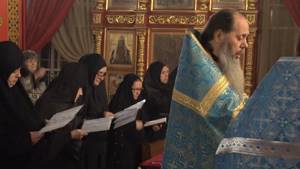
Iconography
A huge number of icons were painted in honor of the birth of the Immaculate Virgin Mary. The oldest painting that has survived to this day is considered to be the painting of the Georgian temple in Ateni, dating back to the 11th century. In honor of the Nativity of the Virgin Mary, a fresco was painted in the apse of the Kyiv St. Sophia Cathedral. This image also dates from the 11th century. An ancient drawing in honor of the birth of Mary is in the Transfiguration Cathedral of the Mirozh Monastery, in the Serbian Church of Joachim and Anna in the Studenica Monastery.
Ancient icons depict the most holy Anna lying on a high bed. Icon painters painted her figure larger than other characters. Women with gifts stand near the woman in labor. In the foreground of the composition is Mary being bathed by her maids in the font.
On icons of the late period, tables were depicted with gifts brought in honor of the birth of the Mother of God. Icon painters also depicted the background story of the birth of the Immaculate Virgin. They painted icons where the high priest refuses to accept gifts from Joachim, as well as a plot where Mary’s father cries in the desert, and her mother prays in the garden. There are icons where the parents of the Most Holy Theotokos meet at the Golden Gate. Icon painters depicted the holy couple alone or with a baby in their arms.
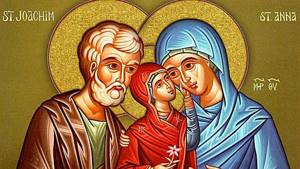
What not to do on this day
On the Nativity of the Virgin Mary, it is forbidden to quarrel and conflict with family, friends and neighbors. On this bright holiday, it is recommended to go to church, pray to Saint Mary and spend the whole day in prayer and glorification of the Immaculate Virgin.
On September 21, Christians fast if the holiday falls on Wednesday or Friday. Traditionally, pies with fish and mushroom filling are baked on the Second Most Pure Day. On this day, it is imperative to treat the poor and give alms to the poor. Even the crumbs from the table must be fed to the animals. If you fail to give gifts to low-income people for the holiday, then wealth may leave your home.
It is forbidden to walk barefoot on the ground on September 21. After all, on this autumn day winter is knocking on the door, and a barefoot person can catch a cold and become seriously ill. You cannot wear new or tight shoes on the Second Most Pure Day, especially those that cause calluses. This is not good. Signs associated with bare feet are associated with Mary, who walked without shoes during her life.
On the Second Most Pure Day you cannot garden, clean the house, chop wood, mow hay, or sew. All matters must be postponed until later. It is prohibited to pick up knives or scissors on this day. During her lifetime, the Mother of God suffered from an attack by robbers who wounded her with a knife. Even the bread for the Nativity of the Virgin Mary must be broken off by hand.
Trinity and Parents' Saturday
Every year, Trinity Parents' Saturday is celebrated before the day of the Holy Trinity. This year the celebration will take place on May 26, 2018, and the day of the Holy Trinity will come the next day. The day is considered mournful; on this day, deceased relatives are remembered. Memorial services are held in every church on Parents' Saturday.
Many people are interested in why this day is called Parents' Saturday. According to some opinions, the day has this name because for every believer one of the sacred duties is to read a prayer for parents.
It is recommended to spend this day in silence, reflecting on life, praying. The next day it is customary to enjoy life, as the day of the Holy Trinity comes.
Old Believer churches
The Nativity of the Most Holy Theotokos, as a great holiday, has always been revered by Russian Old Believers. In honor of this event, Old Believer churches were even consecrated. For example, in the city of Orekhovo-Zuyevo, Moscow region in Russia, there is still a functioning Church of the Nativity of the Blessed Virgin Mary, built by Old Believers back in 1884. The ancient building is protected by law.
In the city of Vilkovo, Odessa region in Ukraine, there is a church founded in the 19th century in honor of the Nativity of the Virgin Mary, also built by Old Believers. Another ancient Old Believer temple, built in honor of the birth of the Immaculate Virgin, is in the village of Cherten, Kaluga region in Russia. True, the church is desolate and destroyed.
Church fasts in 2020
Great Lent.
During the period from February 19 to April 7, a Christian observes one of the most difficult fasts. In this way, a person prepares for the holiday of Holy Easter. These days are dedicated to Jesus Christ, who fasted for 40 days in the desert.
Petrov Post.
From June 4 to July 11, Orthodox Christians will honor Saints Peter and Paul, who fasted before spreading the Gospel.
Assumption Fast.
August 14 – August 27 are days of fasting dedicated to the Feast of the Dormition of the Virgin Mary. As with any other fast, meat, dairy products, and eggs are prohibited. Vegetables, fruits, and boiled food without oil are mostly allowed.
Christmas post.
Or, as it is also called, Philip's fast. Installed in honor of the Nativity of Christ. Observed November 28 – January 6.
